
Invitation to Show and Tell
For two decades Cool Tools has published reviews written by readers and fans of this site. To continue this tradition, we are now inviting reviews in the form of videos. The technology for taking a simple video is now accessible on phones, and the apps to edit them are easy enough for us to use. We are now ready to take user-made videos that recommend cool tools.
We will take very short (3 minute max) reviews, edit a few of them together, and post them on our YouTube channel.
Here is an example of what we are looking for:
https://youtu.be/BjSly6DoZz8
The important details: Record your review with your phone in HORIZONTAL (landscape) mode. This ensures it transfers to YouTube easily. We can not accept portrait mode (tiktok) videos. Avoid showing your face, or talking facing the camera. Point the camera at the tool, your hands, or torso of someone else using it. The focus is the tool, not the reviewers.
- Show us what the tool does, and how you use it.
- Tell us why it is better than similar things.
- Tell us why we should believe you. (How long have you used it, did you buy it yourself, what experience do you have with these kind of things?)
- Keep it brief. 3 minutes or less.
- Review only tools easily available to others, and include purchasing information/link in your email submission.
- Upload your videos into this form.
As we have always done, we pay for anything we end up publishing. After reviewing all submissions, we pay $25 for any video review we post.
This will be a lot of fun. We don’t have a fixed format for these video reviews, so we look forward to your version of what a great review should look like.
Show and Tell us about your favorite tools. To begin with, it’s okay if we may have already reviewed the same tool in the past on the website. We are broadcasting to a new audience, and they would like to know about the best tools. Tell us about the really great stuff.

TextSniper/An Accidental Life/Discover your sources of pleasure
Grab uncopyable text
I often come across text on my computer that I can’t copy, such as error messages, screenshots, PDFs, or Kindle Cloud reader pages. I bought a $4 optical character recognition utility called TextSniper that lets me grab uncopyable text that’s on my display and save it as plain text to the clipboard. (It also reads QR and barcodes!) I quickly have become dependent on it. (It’s Mac-only.) — MF
Strange Autobiography
Charles Platt is a science fiction writer who was also a staff writer for Wired magazine. He is not well known, and does not have an extravagant life story, but for some reason I could not put down his multi-volume self-published autobiography which is subtitled: “How I Failed at Almost Everything.” I found his nearly day-by-day memoirs of his struggles to be a writer and zine publisher to be page-turning exciting because he had just enough success so that his inevitable personal failures would make a rollicking roller coaster ride, like a good sitcom. How will Charles screw up next? Despite the stack of unread bestsellers on my table, I’ve read Vol1, Vol 2, and Vol 3 of his An Accidental Life, and look forward to the soon to be published Vol 4 and 5. — KK
Coupling pleasures with chores
I beta-tested one of Clearer Thinking’s mini-programs to help identify my greatest sources of pleasure, which is important to know, because “positive emotions are one of the pillars of well-being. By identifying your Sources of Pleasure, you can pursue them on those times you are feeling a bit low, our use them as a reward for engaging in other activities you do not feel like doing.” My sources of pleasure were mostly sensorial and not surprising to discover: animals, nature, humor. But what was surprising was the genius advice that could apply to everyone: “Coupling” to come up with ways to incorporate pleasure into your daily life. “Couple boring activities, like vacuuming your home, with something you really like to do such as listening to your favorite podcast or singing out loud.” I do love listening to standup comedy while stuck in traffic, I had never thought of listening to it while I cleaned the house. — CD
Take a "golden hour" photo any time of day
I try to veer away from using filters on photos, but there are times when the scene I am seeing is so much more vibrant than what comes out in a picture. I tried out the “TikTok” iPhone photo hack, which is a specific formula for making a photo taken in natural light look like it was taken during the “golden hour,” and I love the effect. Here is a before and after picture of my dog Pablo wading through water. The exact formula is: Exposure and brilliance to 100. Highlights to -32. Shadows to -26. Lower the contrast to -30. Brightness to -15. Black point to 10. Saturation to 10. Vibrance to 8. Warmth to 10. Push the tint up to 29. Up the sharpness to 14. Definition feature to 23. Finally, slide the exposure back down to 0. — CD
Web-based music toy
Beepster is a website that lets you make synthesizer music through experimentation. It has four tracks. You can change the waveform, speed, volume, pitch, and scale by clicking buttons. It’s configured in such a way that anything you do produces a pleasant tune. — MF
Art to follow
Instagram has become one kind of art museum for me. I like to get my art in diverse small doses. Among the artists I follow, I seek these accounts because they keep me surprised.
- https://www.instagram.com/ifyouhigh/ — Different, odd, unexpected, weird. My favorite.
- https://www.instagram.com/vikmuniz/ — Always surprising bits of beauty.
- https://www.instagram.com/rawvisionmagazine/ — Select folk art from magazine.
- https://www.instagram.com/geometriasagrada/ — Geometrical / mathematical art worldwide.
- https://www.instagram.com/ememem.flacking/ — Creative public tile mosaics.
- https://www.instagram.com/okudart/ — Colorful polygon master.
- https://www.instagram.com/studioolafureliasson/ — Star artist’s tech sophisticated installations.
If you have a favorite art follow that always surprises you, let me know. — KK

Paul Boswell, Educational Toy Maker
Our guest this week is Paul Boswell. Paul is co-founder of Turing Tumble. He’s been an analytical chemist, a software engineer, a professor at the University of Minnesota, and a healthcare researcher. Four years ago, he progressed to the next obvious step in his career: becoming a toymaker. His Kickstarter for Spintronics, a puzzle game where players discover electronics in a tangible way, using the first physical representation of electronic circuits, launches on May 20.
Subscribe to the Cool Tools Show on iTunes | RSS | Transcript | See all the Cool Tools Show posts on a single page
Show notes:
Best chemistry demonstration to whip out: Magnesium burning in dry ice
This is a cool chemistry experiment that anyone can understand, and it's a blast to watch. You can whip it out for a birthday party or whatever, and it's really fun to watch. Magnesium metal is a very light, sturdy metal, and it really, really likes oxygen. It wants to bind to it very badly. And you can light it on fire, and it just rips oxygen out of the air and binds to it. It burns super hot and super bright at 3,000 degrees, and at the end, you're just left with this hunk of white material that's magnesium oxide. People normally buy magnesium to start campfires. You can get it on Amazon. So here's what you do. You take two slabs of dry ice — you can get the dry ice from your local grocery store. You drill a little hole in the bottom slab of dry ice. So you have two slabs, and you have one on the bottom, one on the top. And you drill this hole, and maybe it's like two inches diameter, and you put magnesium shavings in the hole. You don't fill it to the top. You leave a little empty space on the top, and then you make sure that the second slab of dry ice fits over the top slab and the hole before you continue. Then you take the top slab off. You light the magnesium on fire, and maybe you need to use a propane torch to get it hot enough. And then you quickly cover it again. Dry ice is made of frozen carbon dioxide. And carbon dioxide, if you don't know, is made of a molecule with one carbon atom and two oxygen atoms. It's a stable molecule, and it doesn't react with hardly anything. Now, the magnesium wants to burn, and it wants to pull oxygen off of something, but there's no oxygen there when it's inside this carbon dioxide block. So how does the magnesium burn? The way it does it is it binds with the oxygen that's in the carbon dioxide. So it actually rips the oxygen out of the carbon dioxide, and what's left is carbon. So the magnesium burns inside the dry ice until it all burns out. And then you open it up, and you see this nugget of burnt magnesium. And you crack open the nugget, and it's just black inside because all that's left is carbon from the carbon dioxide. It glows brightly while it's burning.(image taken from thought.co)

Elmer’s Wood Repair System
If for whatever reason you happen to have little burned holes in your wood flooring or table or whatever, you can actually repair a lot of problems in your wood flooring without having to refinish or replace anything. So we were trying to figure out how to replace or how to fix these little black marks in our wooden floor. And we stumbled across this guy who fixes wood floors for a living, and he came by, and he had this tackle box just full of different types of paint. And the first thing he did is he got this wood repair epoxy, like Elmer's Wood Repair. First, he filled the hole with the epoxy and let it get hard. And then the next thing he did is he painted the grain of wood very carefully with acrylic paint. It turns out the guy was actually an art major who just got really good at painting wood grain and went into doing this full time. So he filled the holes. He painted the grain that was missing. And when he was done, we couldn't even see where the holes had been. So the first half of this you can buy, which is the Elmer's Wood Repair System. The painting is going to be up to you.
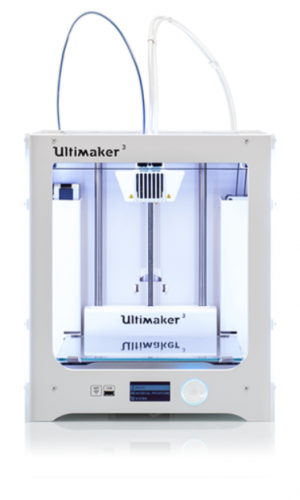
Ultimaker 3
I'm an educational toy maker now, and the type of toys that I make are very mechanical in nature. When I make prototype parts, I use this machine constantly. I’ve tried a lot of 3D printers. The Ultimaker 3 is by far the most reliable machine I’ve used. I can send files to print and they work 9 times out of 10. The dual extrusion lets me print virtually any object and then I can dissolve and wash away the supports with water. It’s expensive and it’s slow, but the time I don’t have to spend troubleshooting problems and the ability to wash away supports makes it totally worth it to me.
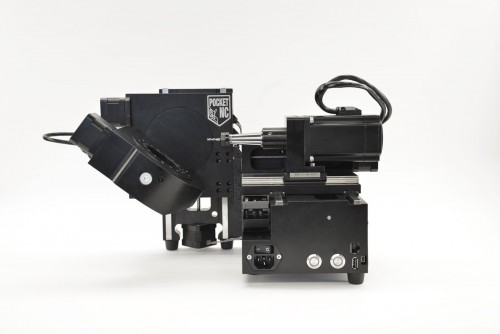
PocketNC
Pocket NC is kind of a miniature CNC mill. CNC stands for computer numerical control. And basically, what it means is that you have a mill, which is just like a router blade spinning really fast on the end of a tool. One way to think about it would be a router blade on a robotic arm that goes around and cuts material out of some block. Whereas 3D printing, you're adding material to build something, with a CNC mill, you're actually subtracting material. You're cutting it away from a block of that material. So most CNC mills are three axis. That means you have like a blade that's spinning, and it can move forward, backward, left, or right, or up and down. And that's great if you have a flat surface, and you're cutting or engraving something from it. But a five-axis CNC mill, like the PocketNC, can not only move forward, backwards, side to side, up or down. It can also rotate along two axis. So you can cut out pretty much anything you want out of a block of material, as long as the blade can get to it to cut out that spot. Usually, these machines are very expensive. They run for well over $100,000. But this little PocketNC is only $6,000, and it's shockingly precise. It only does small objects, so maybe a six inch by six inch by six inch, probably even a little smaller than that. Maybe five by five by five. But it's pretty incredible.
About Spintronics:
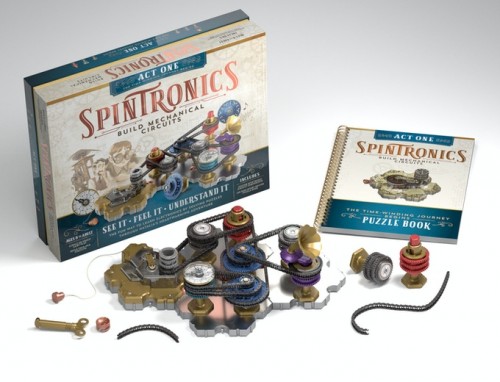
Spintronics! It’s the world’s first mechanical equivalent of electronics. Ever wonder what technology world would look like if electricity was never discovered? Would there even be computers and smartphones? Yes there would. And they would be fabulous and steampunk and the world would be way more awesome.
Spintronics lets you build mechanical circuits that run just like electronic ones. Electronic circuits are invisible and abstract, but spintronic circuits are tangible. It finally lets you feel the voltage and see the current flow. You can use your fingers to mess with a circuit and watch what happens. As you build circuits to solve a series of puzzles, you develop an intuition for electronics without getting tangled up in the math. Even kids can understand university-level concepts.

What's in my desk? — Nathan Baker
Sign up here to get What’s in my bag? a week early in your inbox.
I’m a software engineer, writer, maker, and huge Tolkien nerd. As is true for many makers, I’m fanatical about the tools I use. I’m happy to share a few of my own go-to solutions for common life problems! — Nathan Baker
About the desk
I’ve been working from home since March of last year. My home study is not large enough for two full-size desks, so one of my first pandemic projects was building a second desk for myself. That way I could guarantee it would fit precisely in the space I had available and could maximize surface area and minimize cost and wasted space. The only tool I needed was a drill, and I was able to pick up all the supplies I needed at Home Depot. It paid off that I did my homework beforehand … knowing the exact lengths of 2x4s I needed, they were willing to cut them for me.
What's in the desk
reMarkable 2 ($399)
This writing tablet has dramatically decreased my clutter and increased my organization. Billed as the “world’s thinnest tablet”, it does one thing very well: hand-written documents (ok, it actually does two things well: hand-written documents and annotating PDFs, but I don’t use the latter functionality). Thanks to this device, I no longer find myself scrabbling through endless sheets of paper trying to find the one I took those all-important notes on.
AmazonBasic writing pads ($10, 12pk)
For stuff that I know I’m going to write down and then throw away, these cheap 5x8 writing pads can be bought in bulk. I put them everywhere in my house — I’m rarely out of arm’s reach of one. For jotting down quick thoughts, making temporary lists, doodling, or a hundred other tasks, these are my go-to.
Pentel EnerGel 0.35mm Needle Point pen ($3)
I grew up being told not to waste paper, so I learned to write very small. As a result, I like very, very fine points on my pens. And I absolutely require my pens to write the first time — no scribbling in the margins to get the ink flowing. I carry one of these pens in my pocket everywhere I go, and I keep a couple of them close at hand in my desk drawer.
TuTuShop under-table drawers ($14, 2pk)
I found these in Recomendo issue 223, and they are the perfect addition to my simple, homemade desk. If I find myself needing to store more things than can fit in one of these sliding pencil drawers, I know I need to take some time to declutter. They have a simple adhesive on top that, once stuck, has not failed me yet, and though I’m quite tall they don’t hang down low enough to hit my knees when I swivel in my chair.

Forschner Victorinox Chef's Knife
A really great chef's knife is insanely sharp, yet retains its edge easily and feels well-balanced and welcoming in your hand. These days, a decent high-grade chef's knife can cost $100-$200. Several cooking publications, including Cook's Illustrated, recently tested a bargain chef's knife that rated just about as good as the $100-plus knives. It's the Victorinox Chef's Knife; the one we use.
The Victorinox is a hybrid of a thin Japanese blade with a 15-degree edge (western knives have a 20-degree edge), but with the longer, broader blade of European knives. It is lightweight, nicely balanced, and lethally sharp. It has a comfortable, grippy handle that won't slip even when wet. There are five cooks in our household. This is the knife they all grab first. It may not be quite as super great as some of the other previously-reviewed chef's knives, but considering the price, it can't be beat.

What's in my workshop? — Chris Askwith
Sign up here to get What’s in my bag? a week early in your inbox.
I have been a full time pipemaker for almost 12 years. My pipes are fully handmade using mostly traditional methods and materials in my home workshop and are sold around the world. — Chris Askwith
About the workshop
I use a lot of power tools in my pipemaking but all of the fine detail is done with hand tools, knives, files and sandpaper for the most part. I have tried having all my tools within hands reach as is commonly done by jewellers but found this crowded and encouraged me to get stuck in one position. I now keep most tools just out of reach so I regularly get up from my chair and take the opportunity to stretch and move around a bit, it seems to work well for me even if it is less efficient.
What's in the workshop
Gluing some sandpaper to a bit of wood is an age old trick for making sanding easier, especially for small, flat surfaces. These sandpaper handles or sticks however are so much better. A simple clamp holds the paper in place and it pulls the paper quite taught, it takes just seconds to change the grits (though I prefer to have one for each grit if possible) and the handles make sanding both easier and more comfortable thanks to the file style handle. Quite inexpensive too. Best used with cloth back abrasives I find.
The Shinto saw rasp is a fast and efficient way to remove material without clogging and leaving a smoother surface than a traditional rasp. It has a coarse side and a smoother side and I have found it effective on softwoods, hardwoods and many kinds of plastic and resin.
I have found the Click 2000 Puggy gloves to be the perfect compromise between dexterity and protection in a light duty work glove. They keep my hands warm, allow me to perform reasonably fine tasks, increase my grip and give me a reasonable level of protection against abrasion, scratches and dirt. I wear these pretty much all day in my shop and each pair lasts for several weeks and will handle a couple of cycles through the washing machine as well.
I’ve tried every style of safety glasses/googles over the years and they all have their pro’s and con’s but these from UCI are the best I have found. They are comfortable, fit my face well, give good visibility and seem to be pretty scratch resistant. The foam padding is easily removed if you need more ventilation. Most importantly for me I have found I like the included strap that can be used to hold them just snug to my face, safety glasses slipping forward is big annoyance and danger when using a power tool so this feature is essential for me but way more comfortable than elasticated goggled which are often too tight for long periods of working. Very reasonable price for the quality as well.

See a Satellite/Nesting bowls/Secret Life of Components
Sign up here to get Recomendo a week early in your inbox.
See a satellite tonight
A Google engineer made this cool website where you can track satellites that crawl across your neighborhood sky. It will give you times and names of the satellites that are coming your way and even show you how it’ll appear in the night sky with Google Street View. I’ve been setting alarms on my phone to go outside and look. Of course, it’s made me realize how much light pollution we have. Hopefully, you don’t have as much. — CD
Nesting bowls with airtight lids
Now that my wife and I are vaccinated, we’re enjoying backyard visits with friends. I bought this set of 6 nesting stainless steel bowls. They’re good for bringing food to a backyard barbecue. The largest one is 7 quarts — capacious enough for a large salad. The lids form a tight seal, too, which means they won’t fall off in the car ride over. — MF
Ultimate workshop course
The best course I’ve ever taken in workshop skills is a series of YouTube episodes by the British inventor Tim Hunkin. In his Secret Life of Components he goes through all he knows about the “components” you’d use to build something: glues, fasteners, hinges, bearings, switches, springs, etc., and he knows an awful lot. Every minute is crammed with the practical advice of a master craftsman gained over decades of experience. I’m wowed by how much I learned. — KK
Turn your smartphone into a Game Boy Camera
My daughter bought a vintage Game Boy Camera and thermal printer on eBay. It takes very low resolution photos that have a nostalgic charm. Recently I came across this web-based simulation of the Game Boy Camera. It’s fun to see what things look like in a two-color palette of blocky pixels. Here’s sample. — MF
How to wake up early advice
Here is a 5-step plan for waking up earlier and with more energy shared by u/FrankOppedijk on Reddit. The key advice I found is once you decide how many hours you need for sleep and develop your relaxing bedtime routine, you start by shifting your wake up time by 5 minutes each day, and you energize yourself using various techniques like natural bright light, drinking water, an activating breathing exercise like Bellows Breath, or quick heart-pumping exercise. I found it very encouraging. — CD
The stories of colors
“I love it when someone wakes me up to see what I was sleepwalking through. Adam Roger does that in this book. He showed me that the colors we see everywhere today are technologies we invented! Invented colors! Head explodes!” That’s the blurb I wrote for Roger’s new book Full Spectrum. Reproducing the colors of nature is not easy, yet despite being surrounded by manufactured colors in our modern lives, the story of these inventions are invisible. This is one of those books that opens up a world right in front of my nose. — KK

Lawrence Lazare, Photographer
Our guest this week is Lawrence Lazare. After a 25-year career as an ecommerce product leader, Lawrence recently retired due to the loss of his central vision from a genetic eye disease. In his retirement, Lawrence is concentrating on his infrared landscape photography practice, as well as launching a podcast about maintaining a life-long creative practice.
Subscribe to the Cool Tools Show on iTunes | RSS | Transcript | See all the Cool Tools Show posts on a single page
Show notes:
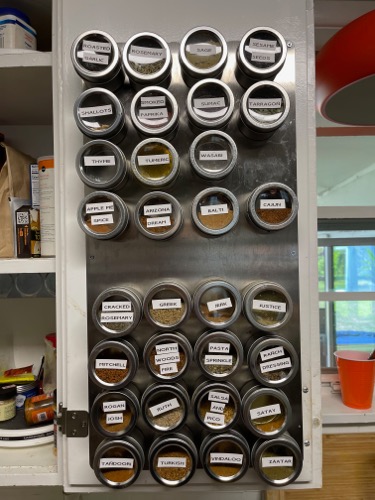
Magnetic Spice Tins ($25, 12pc)
These are spice tins that I got before I lost my vision. But since I've lost my vision, they become even more valuable. They are round metallic spice tins that you stick to a sheet of thin steel that goes inside a cabinet. The idea is you open your cabinet door and there are all these spice tins facing out. So with these spice tins, what I did was hack them where they come with a label that goes over the center of the tin. I started using the old DYMO labels, with a white background with a high contrast black text on them. And then I keep them all alphabetical, so that in general, I kind of know if I'm looking for a specific spice, I'll know where it is. And the other thing that's been helpful is by removing the labels that come with them and using the DYMO labels is I can see a lot more of the color of what's inside there. I can still see many colors, so if I'm looking for paprika, I'll go look for the red tin. Like I said, I had these long before I lost my vision and they've been a lifesaver since I've lost my vision.
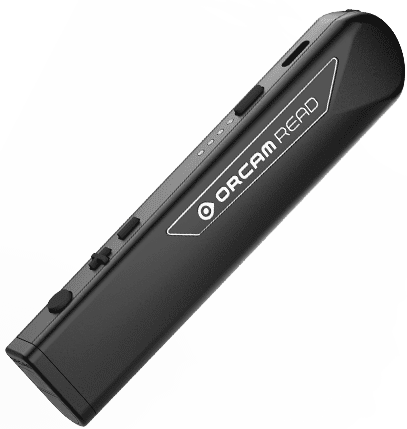
OrCam Read ($2,500)
Of all the tools that I've used since losing my vision, this is the most gee whiz one. This company OrCam has this little reader, that's the size of a Sharpie. And it has an internal computer, it has a laser pointer, a light and a camera. And what you do is you point it at something and it shines a laser pointer at it so that it tells you what it is you're looking at. And then it takes a photograph of what you're looking at, and within maybe under two seconds, it reads to you out loud whatever it just saw. So for instance, if I'm trying to read a recipe, which I really struggle with, I just point this at it and it will read me the whole page. But what makes it even more amazing is it's not internet connected at all, it's all self-contained. So for instance, if I was out in the woods, hiking and I come across a sign to tell you to go this direction and it gives you the name of the trail, and there's no internet connectivity, this thing would work. It awes me how accurate it is. I have another tool for people who just want to check out this technology, given that the OrCam Read is $2,500. There's an awesome tool from Microsoft called Seeing AI and that's free and it has a number of tools. The first one is text recognition, so when you turn it on, it immediately goes into camera mode and whatever it's pointed at, it will read the text, similar to the OrCam Read. It's not as accurate, and the challenge with it is you have to hold it totally still. But like I said, it's a free tool and it has other very cool things like a barcode scanner. So for instance, going to the grocery store for me is a nightmare. So what I can do is I would point this thing at the barcode and it would tell me what the product is. They also have a very cool tool in there that it will read the scene. For instance, if I pointed it at my wife and it said, "35 year old woman smiling with a pair of glasses." And my wife is not 35, and she was delighted by the fact that it said 35 year old woman. And you can point it at the room and it will say, "You're in a room with a table and a couple of chairs.” So this technology is really evolving in front of us.
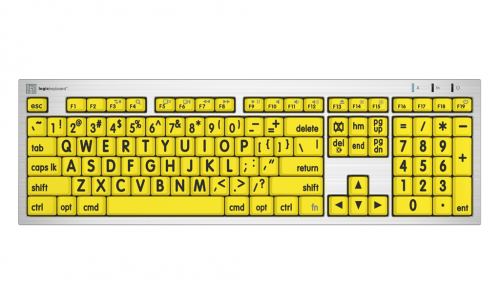
Logickeyboard Large Print High Contrast Keyboard ($115)
This is a tool called the Logickeyboard. When I was still working, one of the things I really struggled with is I'm a Mac user and Mac products are notoriously beautifully designed, but can be a little low contrast. There's no way I can really read my keyboard on my computer anymore. Logickeyboard has a number of keyboards. I got the one that is high contrast, and all the keys are basically yellow. You can get black and white combinations, you can get different color combinations, I have a yellow keys with very large high contrast letters on them, and this has been a life saver for me. They make a lot of multimedia keyboards, like Adobe Premiere. And with those keyboards, they lay out all the macros on the keyboard. They probably put out 20 or more different keyboards for specialized purposes.
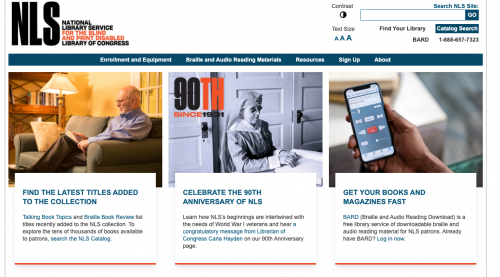
The National Library Service for the Blind and Print Disabled - Library of Congress
This is a service from the Library of Congress, it’s an audio book service for the blind. To get this service you have to get a doctor to fill out the form to qualify for it. It’s basically Audible for free for blind people. And they have a physical player that looks like an old cassette deck, that you plug a USB book into it. But I use the smartphone app and I have a library of hundreds of thousands of books that I can get for free. But the thing that makes it even cooler is the fact that they have audio magazines. The two magazines that I subscribe to are The New Yorker and Wired. And I guess Conde Nast has, has worked out a deal with them, so they have all their magazines there. So I can listen to an audio version of Wired, The New Yorker, and many different magazines will be read to me, which is just amazing. Because that was one of the hardest things about losing my vision, it's not only access to books, you can get books from Audible and lots of audio books services, but magazines was a real loss for me. So this was a real Godsend.
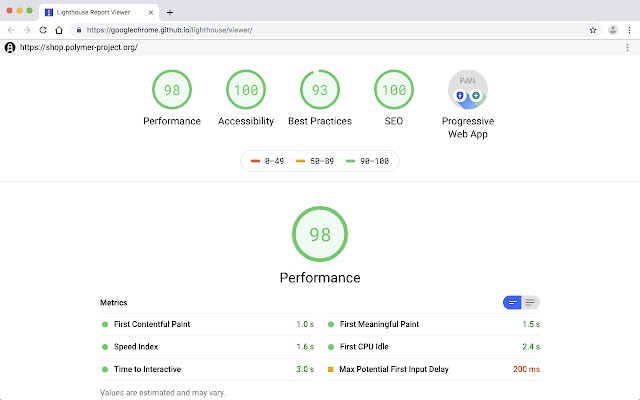
Lighthouse Extension for Chrome (Developer tool that provides accessibility score and recommendations to improve site accessibility)
Websites don't pay much attention to accessibility. For me, the challenge in looking at a website is contrast and font colors. Most websites are not necessarily conscious of the needs of people with disabilities. So there lots of plugins or Chrome Extensions for developers for websites. This one that I picked, the Lighthouse extension, the thing that's great about that is, in addition to SEO and mobile and basically the traditional thing of giving you a score card of how well your website does, this one has an accessibility score that will tell you, "You get a 93 out of a hundred and here's the things that you can correct." And it'll drill down into the DOM to tell you, "Here's the things you need to fix on your website to get a high accessibility score.”

What's in my desk? — Frank H. Wu
I’m an educator and author who moved recently from San Francisco to Queens, New York. During the pandemic, the norm has been work-from-home. — Frank H. Wu
About the desk
Here is what is on my desk in the home office at my apartment in Queens. A good environment produces good work. The desk itself is about as simple as could be, with a “topper” my wife commissioned from a carpenter on Etsy, so as to bring the keyboard up to a good height or even to stand up with the second layer affixed. An inlay shows the silhouettes of our late dogs, Buster and Ding Ding, and our late bird, Little Walter (named for the blues musician). I’ve tried to limit my consumer spending to what is necessary as well as unique, which I am confident I will use regularly. These objects satisfy the test.
What's in the desk
Hyperdrive 18 port hub ($199). This accessory connects an Apple laptop to everything. It would be difficult to imagine more means to plug in than are offered here. For me, it drives two monitors, an external keyboard with old-school mechanical switches, a Yealink speaker for the Zoom conferences which fill the day, and Grado headphones for the music in the evenings, with a slot for digital camera memory cards (when I have time for my hobby of photography), not to mention serving as a pass through power adapter for the MacBook and allowing several other devices to recharge as well.
Rotring mechanical pencil ($28). I always wanted to be an architect when I was young. I loved mechanical pencils and real “lead holders,” but the Rotring was one of those fancy items I wouldn’t have been able to afford. Its industrial design is minimalist and the manufacturing is high-quality, for a tool that seems timeless and unbreakable. Each aspect is functional: a knurled grip on the hexagonal barrel, an indicator for the lead hardness, and a tiny eraser hidden under the cap.
National Brand lab notebook ($12). Although I rely on a computer all day, along with an iPhone and an iPad, I prefer the analog life of jotting down thoughts in ink on paper. The sheets in this hardbound volume are tinted green, which they claim is easier on the eyes; the texture is smooth, with enough thickness to avoid “bleed through” to the other side. I’m old enough to have attended college before laptop computers and the internet, much less smart phones, so there wasn’t a digital option. Afraid they would stop making this product, I bought a lifetime supply years ago, and I’m still working my way through the stack, at the rate of one notebook per year. Since I still consider myself a writer, I love that the pages are numbered.
Wiss scissors, titanium coated ($18). These are sharp and tough, good characteristics for anything and anyone. I wouldn’t have expected scissors to be heirlooms, but I have no doubt that when I shuffle off my mortal coil this purchase will still be around for somebody to grab. I have backup scissors in the belief that two are one and one is none, which are fluoride treated blunt tipped hospital shears, suitable for sanitizing in an autoclave.

Aesthetics Wiki/Hiking snack/Best older iPad
Sign up here to get Recomendo a week early in your inbox.
A wiki of Aesthetics
I’m fascinated by Aesthetics and the people who submerge themselves in these visually-appealing worlds like cottagecore, which is a romanticized interpretation of western agricultural life (Jonna Jinton has mastered this). This Aesthetics Wiki has all the links to everything you would ever need to know about aesthetics, including how to create your own beginning with a wardrobe, or how to go about blending aesthetics to create something new (I’m leaning towards vintage parisian plus surrealism). It is a fantastic rabbit hole. — CD
Hiking snack
My snack of choice while hiking is an RXBar protein bar. Made of egg whites, nuts and fruit and nothing else. They come in lots of yummy varieties but the only one I carry anymore is the chocolate raspberry, which I never tire of. — KK
Best older iPad
[Update - the 8th generation is actually the latest version, and is available at Apple for $429] I wanted to give my daughter an iPad, but I doubted she needed the biggest, most powerful model, which costs as much as a MacBook Air. After poking around on Reddit, I found the consensus was to get an 8th generation iPad. Amazon has 128GB models for under $450. It works with the Apple Pencil and supports the smart keyboard, too. It’s all the iPad she needs for drawing and video streaming. — MF
Light-blocking eye mask
This $8 light-blocking eye mask is my go-to relaxation tool for long flights and drives and meditation and afternoon naps. It’s called a “Men’s Travel Comfort Eye Mask” but it’s one size fits all and has adjustable straps. What makes it better than other inexpensive eye masks is the ultra-soft ridge at the bottom of it that prevents any light from leaking in. This mask + noise-cancelling earbuds are the perfect tools for an at-home sensory-deprivation experience. — CD
Amazing triangle juggler
Seth Godin sent me a link to this YouTube video of juggler Michael Moschen, who bounces balls inside a giant wooden triangular structure. The balls make a pleasant percussive sound, and once Moschen gets going with multiple balls, the performance is spectacular. — MF
Constitutionally entertaining
One text has outsized influence on the US, and indirectly, on the world: The US Constitution. It is a nuanced article that benefits from scrutiny. I greatly enjoyed the Amazon special based on a Broadway show that documents Heidi Schreck’s deep and innovative exploration of this key document. What the Constitution Means to Me is entertaining, funny, sobering, dramatic, educational, clarifying, and enlightening. What more could you ask for from an hour and 44 minutes? — KK

Nicole Harkin, Writer and Photographer
Our guest this week is Nicole Harkin. Nicole’s an award-winning writer and photographer based in Washington, D.C. Her first book, Tilting, A Memoir was released in 2017 and since then she’s been working on a true-life novel about her grandmother. In addition to writing, Nicole is also the founder of the DC Family Biking Facebook page.
Subscribe to the Cool Tools Show on iTunes | RSS | Transcript | See all the Cool Tools Show posts on a single page
Show notes:
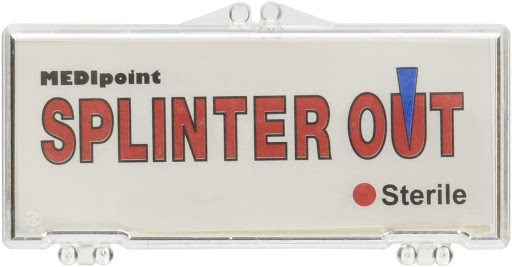
Splinter Out
These are little sterilized metal pieces with a point. They are amazing for removing splitters, which is something of a crisis if you have children. Well for adults too. Splinters suck! What these do is amazing: they get the splinter out without hurting you. I have not interrogated the magic, but I carry these in my wallet now. About $15 for a 5 pack of 20 each.
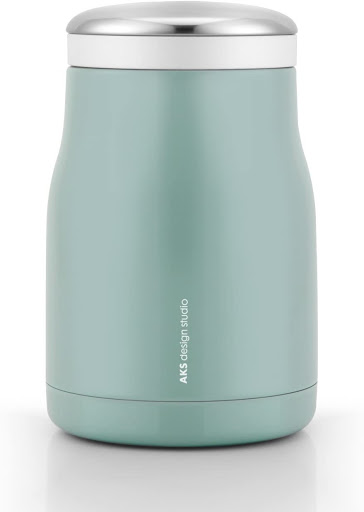
AKS Design Studio Thermos
Before the pandemic a friend bought me this mug from my Amazon wishlist. I liked the color. This thing is amazing. I use it to keep water cool next to my bed. A full 24 hours later the thermos will still have ice in it. Every sip from this thing is a joy. It's double-walled and it won some award. It has a very large wide mouth. So I think you could use it for ramen, and it works for hot or for cold
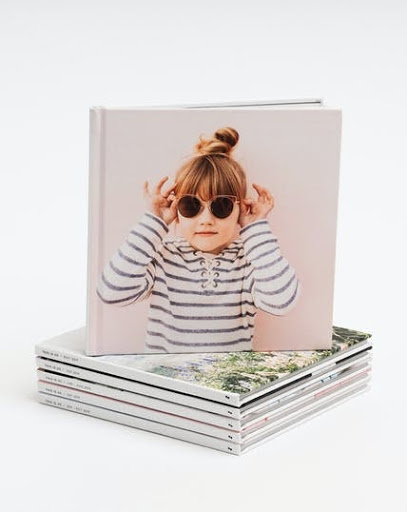
Chatbooks for Instagram
My mother had all of our photo albums completed when she died. She worked on them consistently throughout our lives. I am not my mother. But I feel like I am accomplishing something similar. Every November, I go into Chat Books, re-link my Instagram account, download all of the photos from the year, and have them send me two printed books. I give one to my mother-in-law and keep the other. Since I have two boys, I assume at some point they will each have a set. The key to this system, is taking and posting photos to Instagram. I can also edit out photos from the album, if there is something that is not germain to the year. I paid $44 for two books.
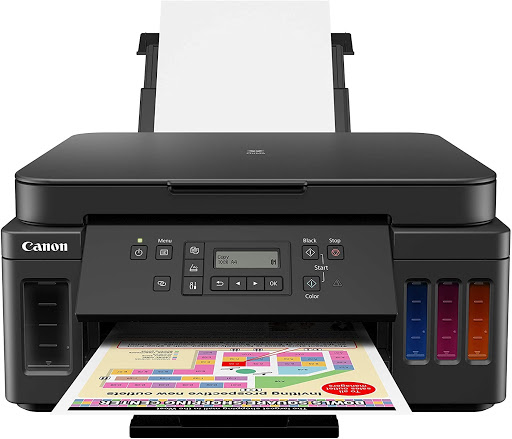
Canon PIXMA Wireless MegaTank All-in-One Printer
These are Ink Jet printers and wireless. What I love about it is the tanks that are in the front of the printer. You can see how much ink is left! When I run out of ink, I will just take more ink and pour it into this receptacle so I can see how much is there and it is using ink much more slowly than the ones with the cartridges. I paid an extra $100 for this version with the tanks, but I can already tell, I'm ahead. Especially with virtual school, this has been a life changer.
About REACH:
With so much social injustice in the world, I was looking for some way to actually make a difference in people’s lives. I found REACH Incorporated, a literacy non-profit in DC where I volunteer in the summer teaching photography or podcasting.
Mark Hecker, the founder, former social worker, and Harvard Grad, started REACH 12 years ago when he realized there was a gaping hole in literacy needs for high school kids in DC. 80 percent of DC public school kids are not reading on grade level when entering high school. In order to improve your literacy you have to read at the level where you currently are. So if you are a 9th grader reading at a 4th grade level, you need to read 4th grade books.
Mark’s insight and genius was starting a reading literacy program in the high school which has the high schoolers tutoring the elementary kids in reading. This is the definition of win/win. The high schoolers practice reading at their actual levels, the kids in elementary schools receive extra help, the high school tutors are paid for their time and thereby learn the soft job skills many are lacking.
If you are looking for a real organization working to make real change on the ground for real people, take a look at REACH.
We have hired professional editors to help create our weekly podcasts and video reviews. So far, Cool Tools listeners have pledged $390 a month. Please consider supporting us on Patreon. We have great rewards for people who contribute! If you would like to make a one-time donation, you can do so using this link: https://paypal.me/cooltools.– MF

99 Additional Bits of Unsolicited Advice
I have another birthday, and another bunch of unsolicited advice.
• That thing that made you weird as a kid could make you great as an adult — if you don’t lose it.
• If you have any doubt at all about being able to carry a load in one trip, do yourself a huge favor and make two trips.
• What you get by achieving your goals is not as important as what you become by achieving your goals. At your funeral people will not recall what you did; they will only remember how you made them feel.
• Recipe for success: under-promise and over-deliver.
• It’s not an apology if it comes with an excuse. It is not a compliment if it comes with a request.
• Jesus, Superman, and Mother Teresa never made art. Only imperfect beings can make art because art begins in what is broken.
• If someone is trying to convince you it’s not a pyramid scheme, it’s a pyramid scheme.
• Learn how to tie a bowline knot. Practice in the dark. With one hand. For the rest of your life you’ll use this knot more times than you would ever believe.
• If something fails where you thought it would fail, that is not a failure.
• Be governed not by the tyranny of the urgent but by the elevation of the important.
• Leave a gate behind you the way you first found it.
• The greatest rewards come from working on something that nobody has a name for. If you possibly can, work where there are no words for what you do.
• A balcony or porch needs to be at least 6 feet (2m) deep or it won’t be used.
• Don’t create things to make money; make money so you can create things. The reward for good work is more work.
• In all things — except love — start with the exit strategy. Prepare for the ending. Almost anything is easier to get into than out of.
• Train employees well enough they could get another job, but treat them well enough so they never want to.
• Don’t aim to have others like you; aim to have them respect you.
• The foundation of maturity: Just because it's not your fault doesn't mean it's not your responsibility.
• A multitude of bad ideas is necessary for one good idea.
• Being wise means having more questions than answers.
• Compliment people behind their back. It’ll come back to you.
• Most overnight successes — in fact any significant successes — take at least 5 years. Budget your life accordingly.
• You are only as young as the last time you changed your mind.
• Assume anyone asking for your account information for any reason is guilty of scamming you, unless proven innocent. The way to prove innocence is to call them back, or login to your account using numbers or a website that you provide, not them. Don’t release any identifying information while they are contacting you via phone, message or email. You must control the channel.
• Sustained outrage makes you stupid.
• Be strict with yourself and forgiving of others. The reverse is hell for everyone.
• Your best response to an insult is "You're probably right." Often they are.
• The worst evils in history have always been committed by those who truly believed they were combating evil. Beware of combating evil.
• If you can avoid seeking approval of others, your power is limitless.
• When a child asks an endless string of “why?” questions, the smartest reply is, “I don’t know, what do you think?”
• To be wealthy, accumulate all those things that money can’t buy.
• Be the change you wish to see.
• When brainstorming, improvising, jamming with others, you’ll go much further and deeper if you build upon each contribution with a playful “yes — and” example instead of a deflating “no — but” reply.
• Work to become, not to acquire.
• Don’t loan money to a friend unless you are ready to make it a gift.
• On the way to a grand goal, celebrate the smallest victories as if each one were the final goal. No matter where it ends you are victorious.
• Calm is contagious.
• Even a foolish person can still be right about most things. Most conventional wisdom is true.
• Always cut away from yourself.
• Show me your calendar and I will tell you your priorities. Tell me who your friends are, and I’ll tell you where you’re going.
• When hitchhiking, look like the person you want to pick you up.
• Contemplating the weaknesses of others is easy; contemplating the weaknesses in yourself is hard, but it pays a much higher reward.
• Worth repeating: measure twice, cut once.
• Your passion in life should fit you exactly; but your purpose in life should exceed you. Work for something much larger than yourself.
• If you can’t tell what you desperately need, it’s probably sleep.
• When playing Monopoly, spend all you have to buy, barter, or trade for the Orange properties. Don’t bother with Utilities.
• If you borrow something, try to return it in better shape than you received it. Clean it, sharpen it, fill it up.
• Even in the tropics it gets colder at night than you think. Pack warmly.
• To quiet a crowd or a drunk, just whisper.
• Writing down one thing you are grateful for each day is the cheapest possible therapy ever.
• When someone tells you something is wrong, they’re usually right. When someone tells you how to fix it, they’re usually wrong.
• If you think you saw a mouse, you did. And, if there is one, there are more.
• Money is overrated. Truly new things rarely need an abundance of money. If that was so, billionaires would have a monopoly on inventing new things, and they don’t. Instead almost all breakthroughs are made by those who lack money, because they are forced to rely on their passion, persistence and ingenuity to figure out new ways. Being poor is an advantage in innovation.
• Ignore what others may be thinking of you, because they aren’t.
• Avoid hitting the snooze button. That’s just training you to oversleep.
• Always say less than necessary.
• You are given the gift of life in order to discover what your gift *in* life is. You will complete your mission when you figure out what your mission is. This is not a paradox. This is the way.
• Don’t treat people as bad as they are. Treat them as good as you are.
• It is much easier to change how you think by changing your behavior, than it is to change your behavior by changing how you think. Act out the change you seek.
• You can eat any dessert you want if you take only 3 bites.
• Each time you reach out to people, bring them a blessing; then they’ll be happy to see you when you bring them a problem.
• Bad things can happen fast, but almost all good things happen slowly.
• Don’t worry how or where you begin. As long as you keep moving, your success will be far from where you start.
• When you confront a stuck bolt or screw: righty tighty, lefty loosey.
• If you meet a jerk, overlook them. If you meet jerks everywhere everyday, look deeper into yourself.
• Dance with your hips.
• We are not bodies that temporarily have souls. We are souls that temporarily have bodies.
• You can reduce the annoyance of someone’s stupid belief by increasing your understanding of why they believe it.
• If your goal does not have a schedule, it is a dream.
• All the greatest gains in life — in wealth, relationships, or knowledge —come from the magic of compounding interest — amplifying small steady gains. All you need for abundance is to keep adding 1% more than you subtract on a regular basis.
• The greatest breakthroughs are missed because they look like hard work.
• People can’t remember more than 3 points from a speech.
• I have never met a person I admired who did not read more books than I did.
• The greatest teacher is called “doing”.
• Finite games are played to win or lose. Infinite games are played to keep the game going. Seek out infinite games because they yield infinite rewards.
• Everything is hard before it is easy. The day before something is a breakthrough, it’s a stupid idea.
• A problem that can be solved with money is not really a problem.
• When you are stuck, sleep on it. Let your subconscious work for you.
• Your work will be endless, but your time is finite. You cannot limit the work so you must limit your time. Hours are the only thing you can manage.
• To succeed, get other people to pay you; to become wealthy, help other people to succeed.
• Children totally accept — and crave — family rules. “In our family we have a rule for X” is the only excuse a parent needs for setting a family policy. In fact, “I have a rule for X” is the only excuse you need for your own personal policies.
• All guns are loaded.
• Many backward steps are made by standing still.
• This is the best time ever to make something. None of the greatest, coolest creations 20 years from now have been invented yet. You are not late.
• No rain, no rainbow.
• Every person you meet knows an amazing lot about something you know virtually nothing about. Your job is to discover what it is, and it won’t be obvious.
• You don’t marry a person, you marry a family.
• Always give credit, take blame.
• Be frugal in all things, except in your passions splurge.
• When making something, always get a few extras — extra material, extra parts, extra space, extra finishes. The extras serve as backups for mistakes, reduce stress, and fill your inventory for the future. They are the cheapest insurance.
• Something does not need to be perfect to be wonderful. Especially weddings.
• Don't let your email inbox become your to-do list.
• The best way to untangle a knotty tangle is not to “untie” the knots, but to keep pulling the loops apart wider and wider. Just make the mess as big, loose and open as possible. As you open up the knots they will unravel themselves. Works on cords, strings, hoses, yarns, or electronic cables.
• Be a good ancestor. Do something a future generation will thank you for. A simple thing is to plant a tree.
• To combat an adversary, become their friend.
• Take one simple thing — almost anything — but take it extremely seriously, as if it was the only thing in the world, or maybe the entire world is in it — and by taking it seriously you’ll light up the sky.
• History teaches us that in 100 years from now some of the assumptions you believed will turn out to be wrong. A good question to ask yourself today is “What might I be wrong about?”
• Be nice to your children because they are going to choose your nursing home.
• Advice like these are not laws. They are like hats. If one doesn’t fit, try another.
For more see my previous 68 Bits of Unsolicited Advice.
Translation in Italian.

Tab Snooze/Percussion massager/Radio Garden App
Sign up here to get Recomendo a week early in your inbox.
Snooze browser tabs to read later
Tab Snooze is a free chrome extension that has replaced my Pocket subscription. I can save articles, videos or any webpage and schedule it to reopen as a browser tab whenever I want. Which works better for me because it was always too easy to forget the articles I saved in Pocket. — CD
Soothe sore muscles
I bought this $55 Actigun percussion massager after my neighbor raved about hers. Instead of just buzzing like most vibrating massagers, a percussion massager rapidly beats your muscles with a hard rubber ball (or other included attachment). It works wonders on my calves, which often get sore because I walk at least five miles every day on a treadmill desk. One day a couple of weeks ago I foolishly wore rubber sandals on the treadmill and my calves were so sore the next day I could hardly walk. A few minutes with this massager made them feel much better. — MF
Radio Garden App
In a past issue of Recomendo I recommended the Radio Garden website, which plays radio station feeds from all over the world. Reader Chris let me know that Radio Garden now has apps for Android and iOS. The functionality of the apps is the same as the website. Chris says, “Basically it’s an interactive map of the world with indicators for thousands of radio stations. You click on one of the green dots and suddenly you’re listening to radio from that part of the world. The sound quality is remarkably good and there are a number of features to enhance the listening experience. I’ve spent hours listening to music from Africa, the Mideast, and Asia already. I must say it’s one of the coolest apps I’ve come across in quite some time. Check it out if you haven’t already.” — MF
Prescription dive mask
I wish I had realized years ago that you can get scuba masks with inexpensive prescription lenses. My wife needs heavy duty glasses, with severe -10 corrections, and was otherwise blind underwater. But she got a great simple diving mask with -10 lenses for $60. This Promate Slender Mask is available with Rx lenses from GetWetStore. Now she can snorkel with the rest of us. — KK
Hidden iPhone scanner
I recently realized my updated iOS has a scanner hidden within my Notes app. It works just as good as the paid subscription app I previously recommended. All you have to do is create a new note in your Notes app and above the keyboard you will find a row of icons, one of which is a camera icon. Select the camera icon and you’ll find the option to “Scan Documents.” Further instructions here. — CD
Best label maker
Two kinds of people in the world: those who put labels on things and those who don’t. I am a labeler. I’ve long had a Brother battery-powered portable labeler, but the new Brother PTD450 is even better because it can connect to my computer via USB, which I find much easier to use if I have a lot of labels to make. Just import the text. All Brothers use the same P-Touch family of waterproof tapes in multi-colors and widths. — KK

The Best Pliers for Making Twisted Wires
https://youtu.be/-791anDceS0
Safety Wire Pliers:
9 Inch Pliers
6 Inch Pliers
Combination Plier Kit
Fancy Reversible Pliers
Featured Video: “Basic Safety Wire Tips part 1 - 2 and 3 bolt patterns”
Transcript link

Vanishing Asia Kickstarter

In a break from our regular programming, I’d like to tell you about something big I’ve been working on for 40 years. It’s not quite a cool tool, except in its capacity to substitute for expensive travel expeditions.
For the past 40 years I have been photographing the disappearing traditions of Asia. I’ve traveled to obscure festivals and into remote hamlets at the end of the road in 35 countries from Turkey in the west and Japan in the east, and everywhere in between. It was like traveling in a time machine in a century before everything was the same. In this old world of Asia, everything was different, and I’ve put all this wonder in one giant book.

I’ve captured those thousands of ways of being different in my project called Vanishing Asia. This book is 1,000 pages long and so oversized that I could not fit it on my lap so I had to divide it into 3 volumes. This 3-volume set contains 9,000 images (and 9,000 captions) and will take you on a trip few have seen. In fact, I can guarantee you that there is no book like this anywhere in the world. It’s an experience much like going back in time for an adventure of exploration, but from your home.
There is also a utility to this mammoth work. Our modern world runs on “thinking different", which is increasingly difficult to do when we are all connected together 24/7. This book, Vanishing Asia, is an aid to thinking different. In its thousand pages are thousands of alternative ways of doing things. To create a new graphic design, I would pay attention to the hand-painted street graphics in India. To design futuristic uniforms for a science fiction world, I would look to the classical fashions of Japanese monks. To invent a new one-person electric vehicle, I’d study the mini-carts on the streets of Indonesia. To fabricate a modern eco-friendly home interior, I’d investigate the wooden architecture of the Dong houses in China. To conjure up the coolest live performance spectacle, I’d watch the elephant processions of Kerala, India. These and many more examples of the new-New, thinly disguised as the old, are displayed in my book. I made this book to help transmit this ancient richness into the future. The abundance of textures, materials, designs, styles, rituals, colors, habits, motifs, and patterns is stunning, and available to all who dive into it.
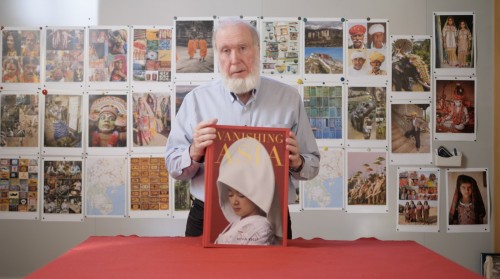
This week I launched a Kickstarter campaign to fund the publication of this massive 3-volume set. I am trying to maximize the number of readers, rather than maximizing revenue, so the Kickstarter offers a steep discount on the eventual retail price ($300) of the books. The Kickstarter rewards are constructed so that the best discounts are given to the earliest backers, with batches of rewards getting slightly less discounted as they are claimed. As of today 200 of the next-best discount of $220 are available but those may be sold out in a few more days.
More details of the book, and a video trailer I made are available on the Vanishing Asia Kickstarter page. I hope you will join me on this adventure and back the book.

What's in my bag? — Ariel Waldman
Sign up here to get What’s in my bag? a week early in your inbox.
Ariel Waldman is the chair of the council for NASA’s Innovative Advanced Concepts program. As PI, she led an expedition to Antarctica to film microscopic life under the ice. She is a National Geographic Explorer and received an honor from the Obama White House as a Champion of Change in citizen science. You can find Ariel on YouTube @ youtube.com/arielwaldman.
About the bag
Nordace Siena – Smart Backpack ($100)
This has been my go-to backpack for the last year. I like that it can expand significantly, but also collapse down to a slimmer profile when not filled up. Lots of different pockets, a water bottle holder, and two separate zippered sections have made it into the versatile bag I need. My only minor criticism is that I usually keep the shoulder straps on their tightest-possible length to get the backpack to fit me the way I want it to, but that might be specific to just me.
What's inside the bag
Muji Gel Ink Ball Point Pen, 0.38-mm, Black ($18, 10pc)
A trusty, precise pen that pairs perfectly with gridded notebooks. This is my most-used pen. It’s not for scribbling quickly, but instead for very thoughtful precision when you’re wanting to carefully map out ideas, drawings, or to-do lists. It also fits perfectly inside the ring-binding of the notebooks I use.
Maruman MNEMOSYNE Notebook, A4 size with a 5mm dot grid ($18)
I love Mnemosyne notebooks and I love dot-grids. I am working on a new book proposal and bought a couple of these to sketch out a couple of different concepts in. I find that getting a large notebook (~8x11") that is more cumbersome to carry around can sometimes help give you a needed push to actually use it instead of throwing it in a pocket “just in case.” In general, I find pen and paper better for brainstorming.
Portable Laptop Stand (out of stock, similar version, $16)
This is a super useful thing I have in my backpack at all times to keep me from injuring my neck due to poor ergonomics. Having a laptop stand that is super lightweight and unobtrusive always comes in handy. Anything you can do to keep your screen closer to eye level is always worth it.
ICZI 10 in 1 USB Type C Dongle ($48)
This is my “everything” dongle. So far, I’ve only needed it and nothing else to be able to plug everything into my MacBook Pro. There are a lot of similar dongles that don’t seem to include everything this one does. The full list is: 4x USB 3.0 ports, a HDMI port, a VGA port, an Ethernet port, a Type C PD 3.0 port, a SD Card Slot, and a Micro SD Slot. For some people, this would be overkill, but for me it’s perfect. In Antarctica, having an ethernet port is super useful; when giving lectures to classrooms, many still use VGA, and having the SD/Micro SD slots continue to be useful for all sorts of cameras. I want to know that if I just remember to bring a single dongle that I’m going to have everything I need.

Great Shop Tips from Colin Knecht
Great Shop Tips from Colin Knecht
[caption id="attachment_37948" align="alignnone" width="600"]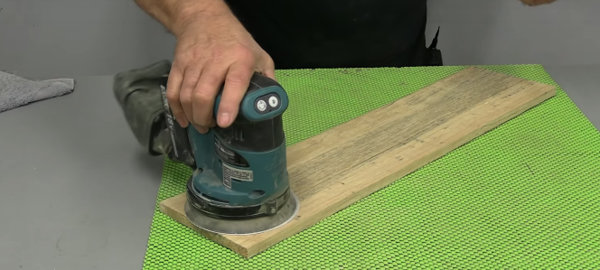 Get a grip![/caption]
Get a grip![/caption]
YouTube woodworker, Colin Knecht, has a fantastic series of videos where he shares his top shop tips and tricks. While these are obviously directed at woodworkers, many of the tips are useful to makers of many stripes. His most recent video in the series is a prime example. There is one tip here about cleaning saw blades, but the cover things, like easily finding the center of a workpiece, trimming “acid brushes” to make them more efficient to use with PVA glue, and using non-skid shelf pads on your bench to hold items you’re working on for sanding and such – these are applicable to many situations.
Which Home Furnace Filter is the Best?
[caption id="attachment_37947" align="alignnone" width="600"] Filter finder.[/caption]
Filter finder.[/caption]
On the amazing Project Farm, Todd wonders what the real performance characteristics and differences are between cheap furnace filters and the expensive ones. As always, he creates testing rigs and puts a whole pile of filters, from $1 to $50, to the test.
Tl;Dr: So which one won? It’s complicated. The thicker filters (2″ and 4″) performed better than the common 1″ filter size, but your furnace may not accommodate a larger size. The permanent, washable filter did not perform well. Nor did the cheap ones. Looks like you want to get the thickest filter your furnace will accommodate and one with the most pleats in the outer filter. Overall, 3M brand filters did really well, like the 600, 1085, and the 1900. (Obviously, you need to get the filter that is the correct dimensions for your furnace.)
Nerding Out Over Pencils
[caption id="attachment_37946" align="alignnone" width="600"]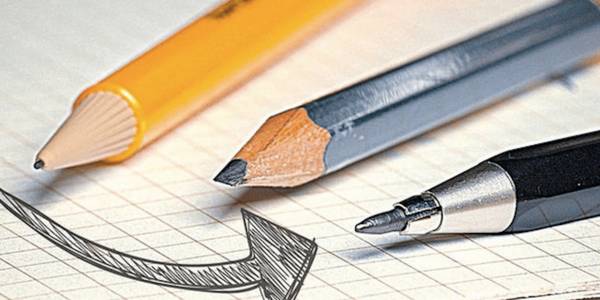 In search of the perfect pencil.[/caption]
In search of the perfect pencil.[/caption]
I got a big kick out of this Make Something video. In it, Dave Picciuto spends 13 minutes talking about some of his favorite pencils while constantly apologizing for spending so much time talking about his favorite pencils. Dave’s favorites (to date) are the Koh-i-Nor Mechanical Clutch Pencil (to keep in his pocket with his Field Notes notebook) and the Paper Mate SharpWriter Mechanical Pencil for having many pencils around the shop.
The C-Thru Triangle
[caption id="attachment_37945" align="alignnone" width="600"] "Memories...misty watercolored memories..."[/caption]
"Memories...misty watercolored memories..."[/caption]
This video from Adam Savage tweaked my nostalgia circuits. Like him, I started my adult worklife as a graphic designer and some of the first tools I fell in love with where the rulers, triangles, mechanical pencils, and pens of that trade. Here, he celebrates a favorite of mine, too, the C-Thru brand (Westcott) gridded triangle. The grid on this thing is perfect for alignment and it has a metal edge so your razor knife doesn’t cut into the plastic. I think I still have mine around here somewhere.

What's in my bag? — Jessica Lahey
Sign up here to get What’s in my bag? a week early in your inbox.
Jessica Lahey is a writer and speaker who lives in the woods of Vermont. She writes about education, substance use disorder, and child welfare for various outlets including The Washington Post and the New York Times, and reviews books for Air Mail. She is the co-host of the #AmWriting podcast with bestselling authors Sarina Bowen and K.J. Dell’Antonia.
When the world is not in the midst of a pandemic, she spends about a third of her time on the road, speaking to parents, teachers, and kids about The Gift of Failure and The Addiction Inoculation. She always has a book in her bag, as she prefers paper to screens, but also adores audiobooks because she can read and knit at the same time.
About the bag
My bag is a black leather Hugo Boss, one I purchased off of Ebay years ago. It’s style number 50274573 and I’d buy a backup if I could. When this bag gives out, I’m going to be devastated, because it’s the perfect size. It fits my laptop, headphones, knitting, a book, and essential travel items, and despite hard wear, the handles have held up beautifully.
What’s inside the bag
Fillion (XL trifold) made by Lesha Shaver of Little Mountain Bindery with a Leuchtturm1917 B5 monthly calendar with journal tucked inside.
This is where the contents of my brain reside until I put them in a book, an article, or an episode of the #AmWriting podcast. I first spotted a Fillion at the Crystal Bridges Museum of American Art store and immediately ordered my own, with my initials embossed on the cover. My two best friends (also my podcast co-hosts) have identical Fillions and journals, and we keep track of our writing goals using stickers. The term “sticker” is our text thread shorthand for “I reached my writing goals today!” so there’s always a sheet or two of stickers in my Fillion as well.
Smythson of Bond Street currency case.
I fell in love with this wallet when I read a New York Magazine piece, “What David Sedaris Can’t Travel Without.” I stalked the wallet, even went to Smythson’s New York City store and fondled it, but could not justify the price. I kept watch for it on Ebay and finally found a used one for much less and it’s become one of my very favorite things. It has four pockets, and I use them for money, business receipts, the Tile I use to keep track of it, and some business cards. I love this wallet so much and it keeps me organized when I’m traveling.
Whatever I’m knitting.
This happens to be a hat for my sister, but I’m a fan of smaller projects. Hats, socks, scarves, that kind of thing. I got my needles at a yard sale, but someday I want to get the Clover Takumi combo interchangeable circular knitting needles set. Someday.
A book.
I get a lot of advance copies for reviews and podcast interviews, but I try to purchase my books at my local independent booksellers, The Vermont Bookshop in Middlebury, the Crow Bookshop in Burlington, or Phoenix Books in Burlington. This book is The Chicken Sisters by K.J. Dell’Antonia, my friend, former New York Times editor, and #AmWriting podcast co-host. The Chicken Sisters is K.J.’s first novel and a recent Reese Witherspoon’s book club pick!

Olight i3E/50 Years of Text Games/Apology tool
Sign up here to get Recomendo a week early in your inbox.
Keychain flashlight
The Olight i3E is not the smallest keychain light. That is still the Photon, powered by a watch battery. But the Olight i3E is the smallest brightest light that runs on an easily available battery: the AAA. It’s the size of your pinky: 2 inches/6 cm long, and costs $10. One AAA will power it for years of occasional use, for when you need light more focused than a phone’s. (And I use a rechargeable AAA.) — KK
History of text games
I played a ton of text adventure games in the 1980s. (Check out the Infocom titles using Archive.org’s early Mac emulator.) I’ve been reading about the origins of text games in a new newsletter called 50 Years of Text Games, by Aaron A. Reed. In the first three issues he takes deep dives into The Oregon Trail (1971), ROCKET (1972) (aka Lunar Lander, which I wrote about in my newsletter, The Magnet), and Hunt the Wumpus (1973). Reed plans to eventually publish a book about text adventure games. — MF
Am I part of the problem?
I just discovered this interactive (and empathic) tool that will walk you through how to apologize. It also helps you understand the difference between intent and impact and the different ways you can make amends — direct, indirect or by example. It’s not designed to make you feel better about yourself, but instead is a useful practice in accountability. — CD
Stop-motion eye candy
I am a fan of Wes Anderson’s movies because of their visual style. In 2018 Anderson released Isle of Dogs, an epic stop-motion masterpiece. Because literally each frame has been designed and crafted in miniature, I think it’s his most visually stylistic movie yet. Every frame is perfect. But there is another reason to stream it now: the very peculiar story concerns a deadly urban pandemic derived from an animal, the spread of conspiracy theories, the denial of science, and a contested election. Feels like it was just made. — KK
Boost your happiness chemicals
Here’s a great list of 100+ hacks for boosting your “happiness chemicals” like dopamine, oxytocin, endorphins and serotonin. The ones I’m most drawn to trying out are: Practicing a power-pose to boost physical and mental confidence. Taking a cold shower to boost adrenaline. And sitting in the sun to boost mental health during the winter. My chocolate lab Pablo sits in the sun everyday, so he must be on to something. Pablo also does the best job of keeping my oxytocin levels high. — CD
Wireless Charging Pad
I got tired of buying Lightning cables, which break frequently so I decided to try a wireless charger pad for my iPhone 12 Mini (most newer phones can be charged wirelessly). It cost less than a lightning cable and now I just set my phone (or AirPod Pros) on it and it starts charging. I’ll never go back to cables. — MF

Keto bread recipe/Slow TV Map/Ancient coins
Sign up here to get Recomendo a week early in your inbox.
Fluffy low-carb bread
Here’s a super-simple recipe for ultra low carb, fluffy bread. I made a 1-minute video that shows how I make it, and the results. This is the almond flour I use. — MF
Slow TV Map
Recomendo reader Mark Jackson shared this wonderful Slow TV Map and said:
“If you haven’t heard of Slow TV before, it is a genre of long-form television originating from the Norwegian Broadcasting Corporation’s broadcast of an uninterrupted 7-hour train journey in 2009. Slow TV Map maps these types of videos on a map so you can discover virtual journeys in an interactive way. Most people use Slow TV as a screensaver, but it can also be used as a form of active meditation. I hope you enjoy!”
Such a great way to virtually visit parts of the world you’ve always wanted explore. Here is a 1-hour long, Slow TV video of an 105-year old ship sailing the Denmark Coastline set to acoustic guitar. — CD
Ancient coin lessons
A fantastic history teaching tool is to give each student a 2,000-year old Roman or Greek coin to clean, study, and keep. Recovered old coins are abundant enough that a bag of uncleaned (and unidentified) ancient coins can be purchased for a few dollars per coin. Of course these coins won’t be high quality; they may be corroded or poorly crafted or well-worn down and indistinct, but they will be authentically old, and actually used as money. That is part of the lesson. Small lots of genuine ancient coins can be bought from reputable sources like Vcoin, where a lot of 20 diverse coins can be $45 (or bit more than $2 per coin). Cleaning them up and trying to identify them gets into their story. Ancient Coins for Education is a resource for educators using old coins, and Kevin’sCoins has tips for cleaning them. — KK
3D printer infographics
If you’re getting started in 3D printing, Billie Ruben’s infographic posters will save you time, money, and frustration. One poster shows how to design shapes that won’t collapse or slide off the plate mid-print. Another helps you select the right design software for your needs, and the third one is a simple (and essential) guide to bed leveling. I’ve been 3D printing stuff for 10 years and learned a lot from these guides. You can buy paper posters here. — MF
Find movies by writing out the synopsis
JustWatch has a cool way to discover new movies to watch. Just type up a synopsis for your ideal movie and you’ll be given a list of films with similar plots. Tip: Press “enter” after you’ve finished typing and the recommendations will refresh. I made the mistake of pressing the “Ghostwrite a story for me” button which overrides whatever you’ve written with a random plot and related movies. — CD
Free Lynda classes
Tutorials on YouTube are near infinite in their variety — and quality. I’ve long paid for a subscription to Lynda.com which provides consistently very high quality tutorials for learning to use design and media software, and for learning how to program and code. The courses are methodical and reliable. I can get up to speed or earn advanced skills pretty quickly. I’ve been using them for learning video editing. Recently Lynda was bought by LinkedIn, and renamed LinkedIn Learning. Their complete catalog of 15,000 courses are made available for free via public libraries in the US. Generally all you need is a library card account to gain access through your local library system. BTW, tons of Recomendo readers reminded me that many of the Great Courses (mentioned previously) are also available online for free via your local library. — KK

